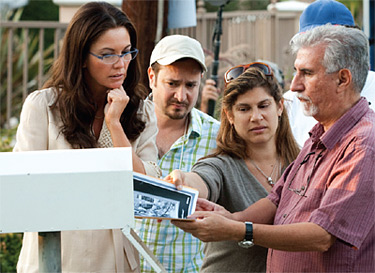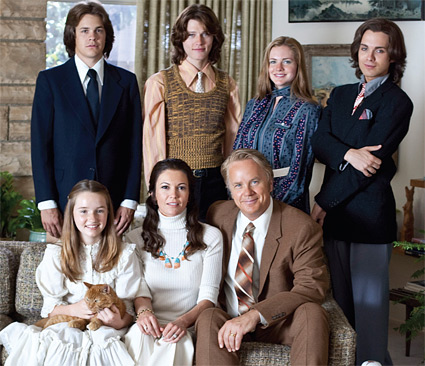Documenting the Reality of Reality TV
Ever wonder when Reality TV began? If you are over the age of 50, you probably think it was Allen Funt's practical gags on "Candid Camera," which debuted in 1948. Or, if you're not as long in the tooth, maybe you think it was that naked guy running around on "Survivor" in 2000 after it was cloned from Sweden's "Expedition Robinson."
But the era of Reality TV as we know it today actually began with a 12-episode series called "An American Family," which ran on PBS from January to March in 1973.
The premise was to find an ideal family and follow them around with 16mm cameras and sound gear to reveal what their lives were really like. To the befuddlement of many, Bill and Pat Loud actually agreed to give filmmaker Craig Gilbert carte blanche to reveal their family's secrets, somehow forgetting in the process how many secrets they had to reveal.
CINEMA VERITE
This year, HBO asked executive producer Gavin Polone to revisit "An American Family." The result was "Cinema Verite," which featured a behind-the-scenes look at the show's creation using documentary-style coverage with actors Tim Robbins playing Bill Loud and Diane Lane as his wife Pat, recreating the Louds' travails with an excellent cast portraying their kids.

Diane Lane, Robert Pulcini, Shari Springer Berman, Affonso Beato on the set. One problem with the choice in cast members was that Robbins and Lane look so much like the people they portrayed that when original footage of "An American Family" was cut into the new version it was hard to tell which footage was real and which was recreated.
But when the 2011 Primetime Creative Arts Emmy Awards were announced by the Academy of Television Arts & Sciences last month, statuettes for "Single-Camera Picture Editing for a Miniseries or a Movie" were presented to Sarah Flack, A.C.E., and Robert Pulcini. Not surprisingly, the awards were handed to them by Bertram van Munster and Phil Keoghan from "The Amazing Race."
Along with editing, Pulcini also served as co-director of "Cinema Verite," so while the production was shooting, Flack assembled the growing mound of source footage until Pulcini could join her once the cameras were silent.
Pulcini recalls that, at first, they simply divided up the scenes of "Cinema Verite" to work on in their own Avid edit bays, assisted by Daniel Triller and Zack Schwartz, but later they collaborated on the whole production.
The "real" parts of the film were shot on 35mm film in 16:9, but the takes that were supposed to be from the film crew's camera were recorded digitally because, as Pulcini put it, "The difference between modern 35mm and 16mm is not as great as it was back then, so we thought we could better manipulate a digital recording to get that grainy, film-like look."
A structural device discovered in the edit bay was to use shots from the original film seen on the Steenbeck edit table that filmmaker Gilbert was supposedly using to cut "An American Family" and split its screen with chapter headings from the film being put together.
"We always wanted to find a way to include some of the original footage," Pulcini said, "to provide some sort of a window into what we were referencing in case the audience did not remember the original film."
The film follows the Loud family through infidelity to divorce to, finally, a sort of reconciliation after the death of their son Lance (played by Thomas Dekker) to AIDS.
THE OLD WITH THE NEW
Having the stylish flexibility of intercutting real footage in 16:9 with the documentary team's camera POV in 4:3 gave Pulcini and Flack unique opportunities to manipulate the pacing.
"One of the most challenging scenes was when Pat Loud asks her husband for a divorce right in front of the kids," Pulcini described. "We wanted it to feel like it was playing out in real time, to sort of stop the rhythm of the film. So we tended to stay with the master Steadicam shot and use 4:3 inserts to delay the pacing. We just let the camera go."
This presented a major contrast to what Flack calls "The Fiesta Scene" during a BBQ at a local Santa Barbara restaurant where Pat Loud reveals to Bill that his unfaithfulness has been discovered.
"This scene was one of the most powerful sequences in the original movie," Flack said, "and we wanted to convey the same sense of what Pat must have experienced. So we portrayed it in a third-party documentary style, with rapid cuts keeping the story moving so the emotional impact seems to be seen from multiple perspectives."

(Clockwise from top left) Johnny Simmons, Nick Eversman, Caitlin Custer, Thomas Dekker, Tim Robbins, Diane Lane, Kaitlyn Dever. Photo by Peter Iovino/HBO During this sequence, filmmaker Gilbert's film crew, Alan and Susan Raymond (played by Patrick Fugit and Shanna Collins), rebels against his intruding too intimately into an intense moment that the family should have a right to keep private, and refuses to turn on their cameras.
"That made this an especially complex scene to edit," Flack detailed. "We wanted to show Craig Gilbert's glee in exploiting a situation that he could put in his movie, so we had to show all the participants and observers and make sure everything matched. We needed to show the interwoven tensions on every level to let the viewers follow all the different conflicts involved."
Another instance when editing creatively affected the story flow came when the mother, Pat, is driving up the coast, mentally recalling how difficult it was to break the news of discovering her husband's extramarital affair to her kids.
"Throughout the movie when we wanted to show what was actually happening compared to what the documentary camera people were seeing, we would often use deliberate intercuts," Pulcini said. "That was a constant dialog in the edit room."
"An American Family" caused quite a stir in its day, with the Loud family universally vilified. Strange as it may seem, after they fought back with personal appearances on "The Dick Cavett Show," each member of the family was able to use the experience to successfully further their careers.
But the reality of this reality show is that it provided a splendid platform for Sarah Flack and Robert Pulcini to honor all editors with their editing skills and bring home that coveted golden Creative Arts Emmy statuette.
Jay Ankeney is a freelance editor and post-production consultant based in Los Angeles. Write him at JayAnkeney@mac.com.
The professional video industry's #1 source for news, trends and product and tech information. Sign up below.
